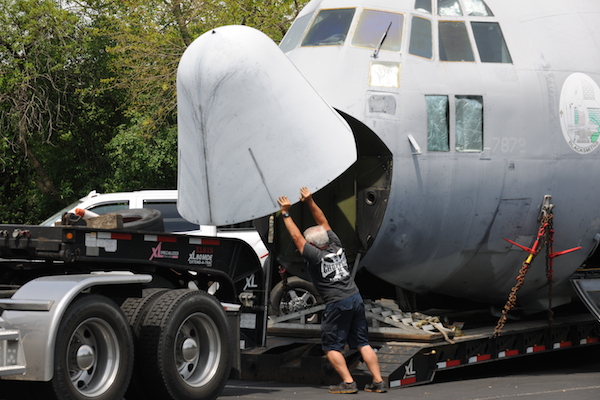President's Blog: From the Heart

A Lab With Wings
By Eric F. Spina
“Hey, who took my parking spot?”
Visitors to Daniel J. Curran Place, home of the University of Dayton Research Institute, are doing a double take when they realize a gigantic Hercules C-130 aircraft has spread its wings in a corner of the spacious south parking lot.
All 133 feet of its wings.
In all honesty, it’s taking up a tad more than a parking spot. Contractors poured a 2,500-square-foot concrete pad (as much as 18 inches deep) to comfortably accommodate the 40-ton airplane that traveled 762 miles, in pieces, on flatbed trucks in May from Eglin Air Force Base in Florida. The plane is being reassembled, and soon a temporary hangar will be built around it, creating a new test lab.
It made its grand entrance in the middle of our spring Board of Trustees’ meeting, giving trustees a bird’s-eye view of a decommissioned airplane that will be used to demonstrate and test a number of innovative technologies to keep the Air Force’s aircraft fleet flying safely.
As an aerospace engineer myself, I am naturally ecstatic about the arrival of this renowned military cargo plane for real-world, hands-on research.
As a history buff, I’m fascinated by its missions, ranging from rescuing hostages in the Belgian Congo to fighting wildfires and participating in oil spill clean-up exercises. Over more than half a century, it’s gained a reputation as a workhorse in the Air Force fleet.
As the president of a major research university, I’m honored that the Air Force chose to collaborate with our world-class research institute, UDRI, on developing groundbreaking technologies to lower the plane’s maintenance costs and improve readiness. Air Force officials believe this is the first time it has physically moved an aircraft to a university for up-close study and R&D.
As one example of work that will be done at UD over the next 18 to 24 months, researchers from UDRI and the Air Force will collaborate on designing and building a robotic system for removing the aircraft’s paint to inspect for corrosion and prepare for a new paint job. The system will be faster, more environmentally friendly, less expensive, and pose less risk to workers.
With the help of students, researchers will scan key aircraft parts with lasers and create 3-D digital drawings to develop precision replacement parts. Because of the age of the aircraft, no drawings are available, so reverse engineering is necessary. Given advances in additive manufacturing — known as 3-D printing — the Air Force can now “produce, on demand, small quantities of aircraft parts that are no longer being manufactured, and at a fraction of the cost of retooling to reproduce the part,” says Brian Stitt, division head for Sustainment Technologies Transition at UDRI.
As I gazed at the C-130 being assembled in a campus parking lot, I thought about the ingenuity of the Wright brothers who built and flew the first airplane and the inventiveness of today’s aerospace researchers who are finding novel, cost-effective ways to keep sophisticated aircraft flying.
Just across the street from Curran Place sits Carillon Historical Park, which houses the 1905 Wright Flyer III in the Wright Brothers National Museum.
Within walking distance of each other, a museum pays tribute to history, while a hangar offers a glimpse into aerospace’s future.
It’s awe-inspiring.
